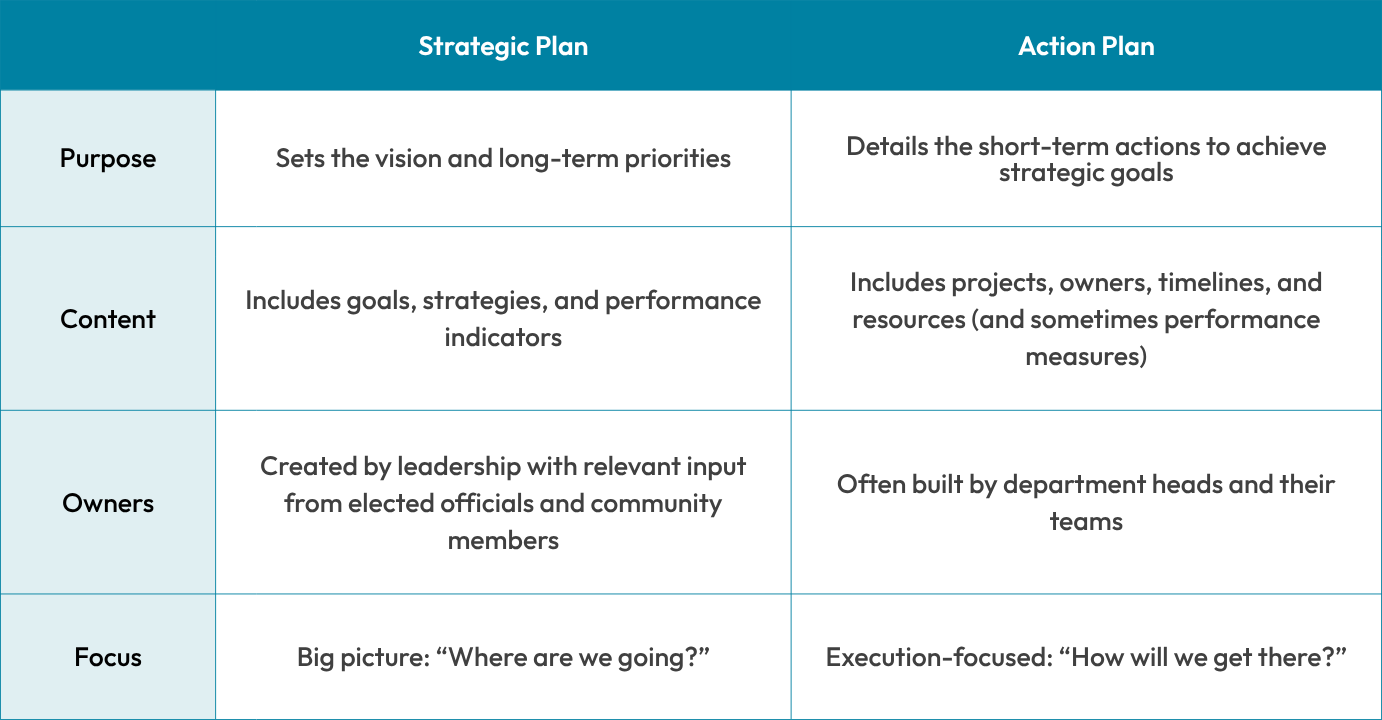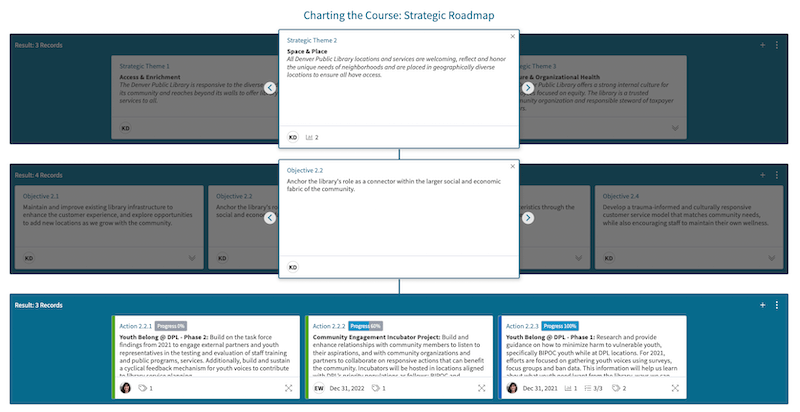Contents
Summary
A strategic plan sets long-term direction. An action plan turns that direction into clear steps, timelines, and responsibilities. Public sector organizations need both to align teams, allocate resources effectively, and deliver measurable results for their communities.
This blog covers:
- The difference between a strategic plan and action plan
- Why both are essential for execution, accountability, and transparency
- How to build an action plan using S.M.A.R.T. actions, budgeting alignment, ownership, timelines, and performance measures
- Real examples showing how structured action planning drives progress
- How visual dashboards help communicate results to leadership and the public
Now more than ever, local governments and other public sector organizations understand the value of developing a strong strategic plan: a shared roadmap that aligns long-term goals with daily decision-making.
Organizations that not only create, but also execute, their strategic plans make the most of their limited budgets and resources, while delivering greater impact for their residents and other concerned parties. A well-crafted strategic plan fosters alignment, builds accountability, and empowers employees at every level to connect their work with a broader mission.
But designing your strategic roadmap is only part of the journey.
Too often, organizations invest time and energy into developing a strategic plan, only for it to stall at the implementation stage. That’s why it’s critical to follow up with a well-structured action plan (sometimes referred to as an operational plan) to bring your strategy to life.
An action plan breaks down strategic priorities into specific, measurable actions with timelines, owners, and resources. Without one, even the most visionary strategy can struggle to move forward.
In this post, we’ll unpack the difference between a strategic plan and an action plan, explain why you need both, and offer a step-by-step framework to help you build an effective action (or operational plan that drives results.
Strategic Plan vs. Action Plan: What’s the difference?
Understanding the difference between strategic planning vs action planning is essential for any organization committed to driving measurable progress.
Both plans are indispensable. Together, they enable public sector organizations to get things done, and better allocate resources.

Based on our experience working with hundreds of public sector organizations, we recommend implementing your strategic plan by developing three, cascading levels (we call this your planning framework):
- Goals
- Strategies
- Actions
Your strategic plan should cover the top two levels of your framework Your action plan makes up the third level of your planning framework.
Here is an example of a three-tiered plan in practice, as laid out in Envisio:

Why You Need Both a Strategic and Action Plan
A strategic plan defines your organization’s direction. An action plan makes that direction actionable.
Without a structured path to execution, even the most ambitious strategy will stall. An operational plan translates strategic priorities into concrete actions—clarifying responsibilities, timelines, and performance expectations.
Together, these two plans form the backbone of effective public sector leadership. They enable your organization to:
- Drive daily decisions with long-term intent
- Embed accountability at every level
- Integrate departmental activities into a cohesive, organization-wide effort
- Allocate resources in alignment with strategic priorities
- Demonstrate measurable progress to elected officials, staff, and the public
This is how strategy becomes action; and action delivers results. Action planning ensures that your strategic intent is converted into measurable, tangible results.
How to Build an Action Plan (with Checklist)
Now let’s help you bridge the practical gap between strategic planning vs action planning:
1. Build S.M.A.R.T. Actions
Actions should be clearly defined, measurable, and feasible. Each action in your plan should be:
- Specific: Clearly articulated and actionable
- Measurable: Tied to a meaningful performance metric
- Attainable: Realistic, given your resources and timeline
- Resourced: Supported by budget, staff, and necessary tools
- Timebound: Structured with a start and end date
Let’s walk through an example together:

- Specific
Santa Fe County’s priorities are translated into clear, focused initiatives—such as strengthening emergency response and improving detention center operations—making the work actionable and well-defined. - Measurable
Progress is tracked through dashboards and updates. Initiatives like the EV Transition Plan and 4Nature Santa Fe! include specific metrics tied to completion rates, grant milestones, and permitting data. - Attainable
Plans are grounded in feasibility. When challenges arise—like staffing gaps or shifting market conditions—the County adjusts scopes and timelines to stay on track. - Resourced
Strategic actions are backed by funding, with state and federal grants supporting EV infrastructure, sustainability upgrades, and emergency services enhancements. - Timebound
Every initiative has a timeline. From policy deadlines to phased climate upgrades, the County outlines when outcomes are expected—and reports transparently on progress.
2. Align with Your Budget
A successful operational plan must be supported by appropriate resources. Align strategic and operational priorities with your budget by:
- Linking funding to strategic objectives
- Using data to guide financial decisions
- Practicing priority-based budgeting
- Involving finance and departmental leaders early in the process
This creates a direct, clear, and defensible connection between resource allocation and desired outcomes.
3. Communicate Your “Why”
Clearly articulate the rationale behind each action and also why your action plan matters. Staff engagement increases when individuals understand how their work contributes to broader organizational goals. To build commitment:
- Explain how actions advance strategic priorities
- Provide specific outcomes and success criteria
- Regularly share updates and progress
Action plans succeed when people are aligned on both purpose and process.
4. Assign Roles and Responsibilities
Ownership is essential. Every action and associated performance measure must have an assigned owner responsible for execution. Strengthen engagement by:
- Involving staff in action creation
- Tapping subject matter experts when building plans
- Giving department heads discretion in defining operational initiatives
The people closest to the work should help define how it gets done.
5. Set Realistic Timelines
Optimism must be grounded in feasibility. Establish timelines based on:
- Dependencies between actions
- Organizational capacity
- Long-term priorities and phasing
Not every action needs to begin on day one. Use your strategic plan’s time horizon to pace initiatives and build momentum over time. Let’s dive into another example.
The City of Gaithersburg’s Economic Development and Redevelopment plan offers a model for how local governments can implement realistic timelines across a range of strategies. Their strategic goal to enhance the stability of the local economic base is operationalized through targeted strategies, with varying progress benchmarks:
- 54% complete: Expanding mixed-income housing options
- 100% complete: Improving access among employment, residential, and amenity nodes
- 74% complete: Positioning Gaithersburg as a regional employment center
- 59% complete: Encouraging reinvestment in aging properties

Progress on each strategy is tracked individually, with updates that reflect program adjustments, funding cycles, and real estate market conditions. Timelines are clearly influenced by feasibility, funding availability, and shifting community needs—demonstrating the importance of pacing, prioritization, and flexibility.
6. Measure and Report on Your Performance
What gets measured gets managed. If you understand how you are performing, you can make better, more agile decisions today, and more informed decisions over the course of your strategic plan. Having performance measures tied to your action plan is a powerful way to stay on track, justify resource allocation, and ensure you understand the impact of your work.
The most effective plan reporting structures:
- Have clearly identified KPIs aligned to each action
- Support internal accountability and visibility through regular staff updates
- Produce regular progress reports for different audiences, at least quarterly
- Enable public transparency with external dashboards
For example, North Grenville’s NGtransit public dashboard shows how the town is tracking progress on transit accessibility, commuter service expansion, and regional partnerships. Updated monthly, the dashboard reflects both current data and upcoming plans tied directly to council updates and funding decisions.

By adopting Envisio, North Grenville can track actions, performance indicators, and maintain strategic alignment, while producing automated reports for council and the community. You can see how, for instance, they measure passenger types and transit booking methods, as well as leveraging heat scoring to understand where the most urgent requirements for transit are.

Check out our complete guide on how to build local government performance measures for more information on how to define and create effective performance measures.
Visualizing Strategy: See It in Action
Bridging strategy and action is easier when your planning framework is visible, accessible, and continuously updated. Visualizing your plans helps staff, leadership, and the public understand how individual efforts contribute to long-term goals.
Envisio’s strategy execution software helps local governments and other public sector organizations to:
- See the hierarchy of goals, strategies, and actions in a centralized system
- Monitor progress through dashboards, status updates, and visual timelines
- Create automated reports that communicate progress clearly to elected officials, internal leadership, and residents
Here is a simplified example of a tiered plan:
- Goal: Improve Community Health Outcomes
- Strategy: Increase access to preventative care
- Action: Launch mobile wellness clinics
Each tier is connected. Actions roll up into strategies, which are aligned with broader strategic goals. As progress is made on each item, performance dashboards and reports can help to tell a story of progress, impact, and accountability.
Visual planning tools bring clarity to complex work, which helps ensure that no part of your strategy is left behind.
A strategic plan gives your organization purpose. Your action plan brings it to life.
Together, they form the foundation of transparent, effective governance. By clearly defining goals, aligning actions with budgets, engaging staff, and tracking performance, you transform high-level priorities into measurable public impact.
Get the Guide↓
If you’re ready to bridge the gap between vision and action, our free guide Operational Planning for Local Governments & Public Sector Organizations, will walk you through every step of the action planning process. You’ll gain access to templates, real-world examples, and expert insights to help your team stay aligned, resourced, and results-focused.





